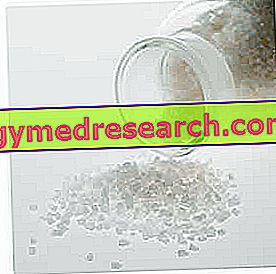Mineral salts
Mineral salts are non-energy nutrients, present in small quantities in food. In nature they are very common because they represent the main constituents of the rocks.

- Bone structure
- Combined with organic substances
- In solution in organic liquids
Chemically, mineral salts are neutral INORGANICS which tend to dissociate in solution, forming POSITIVE (cation) and NEGATIVE (anion) ions, but they can also be classified according to their respective needs (the amount the body needs to maintain full functionality). metabolic):
- Macroelements : mineral salts present in a fairly high quantity, whose requirement exceeds 100mg / day
- Microelements or trace elements : mineral salts present in small quantities, whose requirement is limited and does not exceed 100mg / day.
Some mineral salts perform a plastic function, as they participate in the structure of the human body, while others are bioregulators since they participate in the metabolic reactions and in the activity of enzymes.
NB. For those mineral salts present in very low quantities of which the recommended rations are not known, the words "necessary in traces" are used.
| MINERAL SALTS PRESENT IN THE HUMAN ORGANISM | |
| MINERALS | QUANTITY IN THE GRAM ADULT (g) |
| macronutrients | |
| Calcium (Ca) | 1200 |
| Phosphorus (P) | 850 |
| Potassium (K) | 180 |
| Sodium (Na) | 64 |
| Chlorine (Cl) | 74 |
| Sulfur (S) | 300 |
| Magnesium (Mg) | 25 |
| MICROELEMENTS | |
| Iron (Fe) | 4.5 |
| Zinc (Zn) | 2 |
| Copper (Cu) | 0.1 |
| Iodine (I) | 0025 |
| Fluorine (F) | 2.6 |
| Chrome (Cr) | 0006 |
| Cobalto (Co) | 0.0015 |
| Silicon (Si) | 0024 |
| Vanadium (V) | 0018 |
| Selenium (Se) | 0017 |
| Tin (Sn) | 0013 |
| Manganese (Mn) | 0012 |
| Nickel (Ni) | 0010 |
| Molybdenum (Mo) | 0009 |
Mineral salts Macroelements: functions
Macroelements mineral salts are less numerous than microelements or trace elements; they are called macroelements as their dietary intake must be greater than 100mg / day; below we will list their main functions.
Calcium and phosphorus (but also magnesium and fluorine) are fundamental components of bones and teeth; calcium participates in the coagulation of blood, in the conduction of nerve impulses, intervenes in muscle contraction and regulates the permeability of vessels. Phosphorus is part of phospholipids (cell membranes), nucleic acids (DNA and RNA), of the ATP energy molecule, of some enzymes and (like potassium, chlorine and sodium) participates in the acid-base balance of body.
Magnesium, in addition to being an essential constituent of the skeletal system, enters the composition of numerous enzymes and intervenes in neuromuscular transmission.
Potassium and sodium regulate: the acid-base balance of the body, the water balance, the osmotic pressure and the nervous function.
Chlorine is essential for the formation of hydrochloric acid as a component of digestive digestive juices and, as anticipated, also regulates the body's acid-base balance and osmotic pressure.
Sulfur is a component of some important amino acids called sulphurs (cystine, cysteine and methionine), vitamins, coenzymes and the anabolic insulin hormone; it is abundant in the skin, hair and nails of the human being.
Mineral salts "Main" microelements or trace elements: functions
Iron and copper are two trace elements closely related to each other; iron is essential for the synthesis of hemoglobin, a protein that binds oxygen contained in red blood cells and muscle myoglobin. Copper (and, in part, also cobalt), in addition to facilitating the absorption of iron, enters the synthesis mechanism of hemoglobin, favoring it. Iron is also a component of enzymes of energy metabolism, while copper forms several digestive enzymes and determines the formation of elastin.
Molybdenum composes some enzymes that participate in the metabolism of purine bases (constituents of nucleotides).
Zinc is an enzymatic component that is found both in the catalysts of nucleic acids and in digestive ones; participates in the sensory functioning of taste and smell.
Iodine is a very important component of thyroid hormones thyroxine and triiodothyronine, therefore (together with the cobalt that participates in the iodine fixation reaction) it represents an element of bodily bioregulation.
Fluorine, as anticipated, participates in the maintenance of the bone and dental structure, and also performs a real shielding action against caries.
Manganese is a component of numerous enzymes that participate in the biosynthesis of cholesterol and the metabolism of amines in general.
Chromium is involved in glucose and lipid metabolism; it is a component of a factor called GTF that enhances the activity of the hormone insulin in glucose transport.
Cobalt participates in the various functions of cyanocobalamin (vit. B12), influences the biosynthesis of hemoglobin and facilitates fixation of thyroid iodine.
Selenium is a coenzyme of glutathione peroxidase, it acts as an antioxidant protecting cell membranes and counteracting the negative action of free radicals.
Concluding
Mineral salts, both macroelements and trace elements or trace elements, are essential molecules for the body; the fact that some of them are not difficult to introduce sufficiently does not mean that they are nutrients to be neglected. A condition of general malnutrition always determines also a hydro-saline imbalance, which must be appropriately compensated in order to restore total organism homeostasis.
Bibliography:
- Food and health –S. Rodato, I. Gola - Clitt - pag. 128: 134



